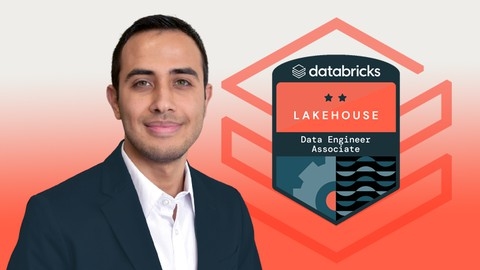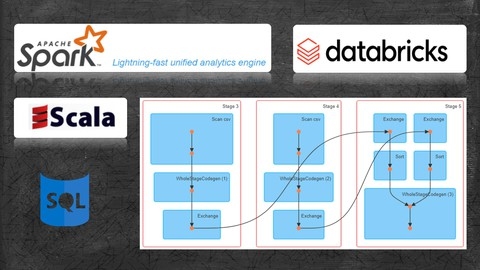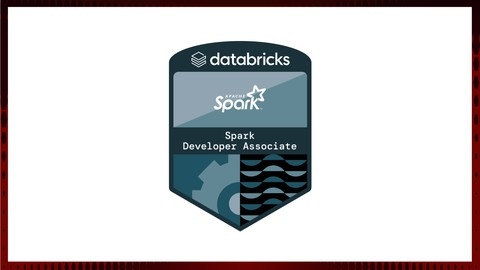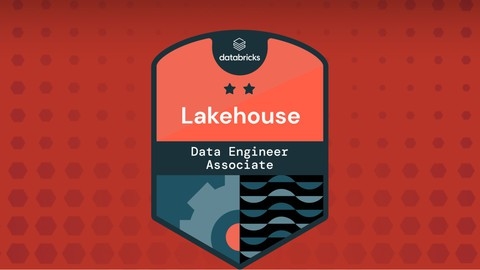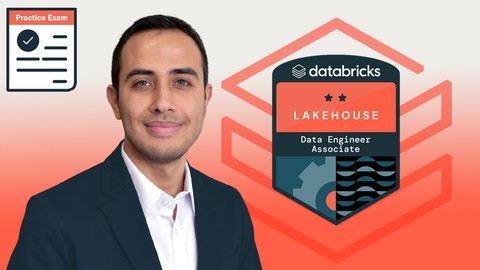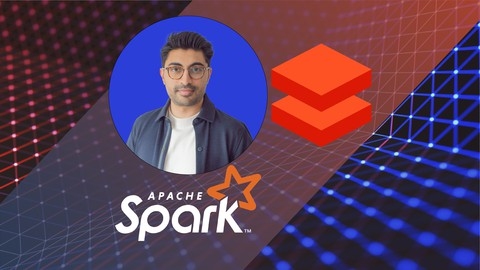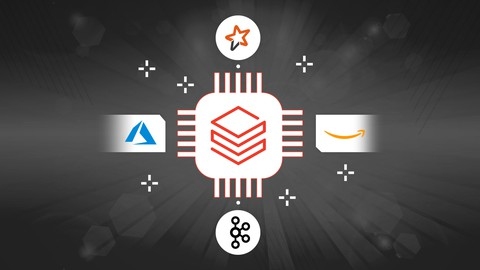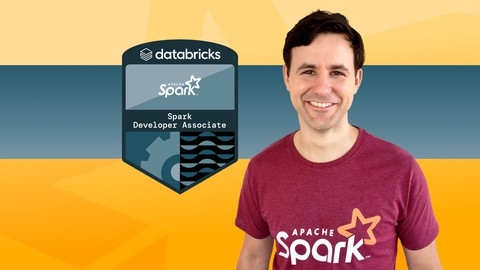Databricks is a cloud-based platform for data engineering and analytics, built on top of Apache Spark.
It offers a unified environment for data ingestion, processing, transformation, and visualization, making it a powerful tool for businesses of all sizes.
Learning Databricks can help you become a skilled data engineer, enabling you to build and deploy data pipelines, perform complex data analysis, and contribute to data-driven decision making.
Finding a high-quality Databricks course on Udemy can feel overwhelming, with so many options available.
You’re looking for a course that is comprehensive, engaging, and taught by experts, but also fits your learning style and goals.
You want a course that goes beyond theory, providing practical experience and hands-on projects to solidify your understanding.
We’ve reviewed countless courses and based on our analysis, "Azure Databricks & Spark For Data Engineers (PySpark / SQL)" is the best course on Udemy overall.
This comprehensive course covers a wide range of topics, from the fundamentals of Azure Databricks and Spark to advanced concepts like Delta Lake, incremental data loading, and integration with Azure Data Factory.
The instructor provides clear explanations and demonstrations, making it easy to follow along and understand the concepts.
While this is our top pick, there are other great options available, depending on your specific needs and interests.
Keep reading to discover a curated list of Databricks courses on Udemy, including options for beginners, intermediate learners, and experts, as well as courses focusing on specific Databricks features and tools.
Azure Databricks & Spark For Data Engineers (PySpark / SQL)
This course covers a wide range of topics, from the basics of Azure Databricks and cluster management to advanced concepts like Delta Lake, incremental data loading, and integration with Azure Data Factory.
It starts with an introduction to Azure Databricks, its architecture, and how to create a Databricks service.
You’ll learn about the different types of clusters, their configurations, and pricing.
The instructor also covers important topics like cost control and cluster policies.
Next, you’ll dive into Databricks notebooks, which are the primary interface for working with Spark.
You’ll learn about magic commands, Databricks utilities, and how to access data from Azure Data Lake using various authentication methods like access keys, SAS tokens, and service principals.
The course also covers best practices for securing secrets using Azure Key Vault and Databricks secret scopes.
One of the highlights of the course is the Formula1 project, which runs throughout the course.
You’ll learn how to ingest data from CSV and JSON files, process multiple files, and use Spark SQL to analyze the data.
The instructor covers important transformations like filtering, joins, and aggregations, as well as window functions and temporary views.
As you progress through the course, you’ll learn about Spark SQL databases, tables, and views.
You’ll create tables from various data sources and perform complex analyses using SQL.
The course also covers data visualization using Databricks dashboards.
In the later sections, you’ll learn about incremental data loading and the Delta Lake format, which addresses some of the pitfalls of traditional data lakes.
You’ll implement incremental loads using notebook workflows and learn about advanced Delta Lake features like updates, deletes, and time travel.
The course also covers integration with Azure Data Factory, including creating pipelines for data ingestion and transformation.
You’ll learn how to handle missing files, debug pipelines, and create triggers for automated execution.
Finally, the course introduces Unity Catalog, a new feature in Databricks that provides a unified governance model for data and AI assets.
You’ll learn about the Unity Catalog object model, how to access external data lakes, and how to create storage credentials and external locations.
The course includes a mini project that puts all these concepts together.
Throughout the course, you’ll work with a variety of technologies and tools, including Python, SQL, Delta Lake, Azure Data Lake, Azure Data Factory, and Power BI.
The instructor provides clear explanations and demonstrations, making it easy to follow along and understand the concepts.
Databricks Certified Data Engineer Associate - Preparation
The course starts with an introduction to Databricks, guiding you through setting up a free trial on Azure and exploring the workspace.
You’ll learn the fundamentals of creating clusters, working with notebooks, and leveraging Databricks Repos for version control and collaboration.
Next, you’ll dive into the Databricks Lakehouse Platform, where you’ll gain a deep understanding of Delta Lake, an open-source storage layer that brings reliability and performance to data lakes.
Through hands-on exercises, you’ll explore advanced Delta Lake features and learn how to set up Delta tables.
The course also covers relational entities like databases, tables, and views, enabling you to work effectively with structured data on Databricks.
One of the key aspects of this course is its focus on ELT (Extract, Load, Transform) using Spark SQL and Python.
You’ll learn how to query files, write to tables, and perform advanced transformations.
The hands-on approach allows you to apply higher-order functions and SQL UDFs to solve real-world data challenges.
As you progress, you’ll explore incremental data processing using Structured Streaming and Auto Loader.
These powerful tools enable you to handle real-time data streams and efficiently ingest data incrementally.
You’ll also learn about the multi-hop architecture, which allows you to build scalable and fault-tolerant data pipelines.
The course dedicates a significant portion to production pipelines, where you’ll gain hands-on experience with Delta Live Tables (DLT) and Change Data Capture (CDC).
You’ll learn how to process CDC feeds with DLT and orchestrate jobs to automate your data workflows.
Additionally, you’ll explore Databricks SQL, a powerful tool for querying and visualizing your data.
Data governance is a critical aspect of any data engineering role, and this course ensures you’re well-prepared.
You’ll learn how to manage permissions and work with Unity Catalog to enforce data access controls and maintain a single source of truth for your data assets.
Throughout the course, you’ll have the opportunity to apply your knowledge through hands-on exercises and real-world scenarios.
The course materials are designed to reinforce your learning and provide you with practical experience that directly translates to the certification exam and your future data engineering projects.
By the end, you’ll have a solid foundation in Databricks and the skills necessary to tackle the Databricks Certified Data Engineer Associate exam with confidence.
Databricks Fundamentals & Apache Spark Core
This course takes you on a journey from setting up your Databricks account to mastering advanced data manipulation techniques using Apache Spark and SQL.
You’ll start by creating a Databricks community account, installing the necessary datasets, and getting an overview of the data you’ll be working with.
The course then dives into the fundamentals of Databricks and Apache Spark, teaching you how to create clusters, notebooks, and run your first Spark code.
You’ll learn about the Apache Spark architecture and how it runs on a cluster.
Next, you’ll explore the DataFrame API, which is essential for data engineering tasks.
You’ll learn how to create DataFrames from CSV files, configure options for reading data, select and reference columns, and understand the DataFrame schema.
The course also covers specifying schemas using DDL-formatted strings.
As you progress, you’ll discover how to transform data using the DataFrame API.
This includes adding, renaming, and removing columns, filtering rows, joining multiple DataFrames, and performing various aggregations like count, min, max, sum, and average.
You’ll also learn how to group data and practice solving real-world business queries.
The course then delves into Spark SQL and SQL fundamentals.
You’ll learn how to run SQL on DataFrames using TempViews and GlobalViews, manage databases and tables, and master essential SQL concepts like the SELECT clause, WHERE clause, handling NULLs, aggregations, GROUP BY, HAVING, ORDER BY, joins, predicates, and CASE expressions.
You’ll have the opportunity to apply your SQL skills in practical business query exercises.
Working with different data types is another crucial aspect covered in the course.
You’ll learn how to specify DataFrame schemas using StructType, convert literals to Spark types, and handle booleans, numbers, strings, dates, and timestamps.
The course also covers complex types like structs, arrays, and maps, as well as handling NULL values.
The syllabus includes a chapter on data sources, teaching you how to read CSV and JSON files using the DataFrameReader and write data using the DataFrameWriter.
You’ll also learn how to create DataFrames manually.
By the end of the course, you’ll have a solid foundation in Databricks and Apache Spark, empowering you to tackle real-world data engineering and analysis tasks.
The course even includes a bonus lecture to help you become Apache Spark certified.
Apache Spark 3 - Databricks Certified Associate Developer
You’ll start by learning how Apache Spark runs on a cluster, understanding the architecture behind distributed processing.
The course guides you through creating clusters on both Azure Databricks and the Databricks Community Edition, so you can get a feel for the platform regardless of your preferred environment.
Next, you’ll dive into the concept of distributed data, focusing on the DataFrame - the core data structure in Spark.
You’ll learn how to define the structure of a DataFrame, perform transformations like selecting, renaming, and changing the data type of columns.
The course also covers adding and removing columns, basic arithmetic operations, and the important concept of DataFrame immutability.
As you progress, you’ll explore more advanced DataFrame operations such as filtering, dropping rows, handling null values, sorting, and grouping.
You’ll learn how to join DataFrames using inner, right outer, and left outer joins, as well as appending rows using the Union operation.
The course also touches on caching DataFrames, writing data using DataFrameWriter, and creating user-defined functions (UDFs) to extend Spark’s functionality.
In the later sections, you’ll gain insights into Apache Spark’s execution model, including query planning, the execution hierarchy, and partitioning DataFrames.
You’ll even get an introduction to Adaptive Query Execution, a powerful optimization technique in Spark 3.
Throughout the course, you’ll have the opportunity to test your knowledge with quizzes on key topics like accessing columns, handling null values, grouping and ordering data, and joining DataFrames.
By the end, you’ll have a solid understanding of how to work with Spark and Databricks to process and analyze large-scale datasets.
Well-prepared to take the Databricks Certified Associate Developer for Apache Spark exam!
Databricks Certified Data Engineer Associate Practice Exams
Through a series of five comprehensive tests, you’ll gain hands-on experience with the Databricks Lakehouse Platform and its various components.
As you progress through the tests, you’ll develop a solid understanding of the Lakehouse Platform’s architecture and capabilities.
You’ll learn how to navigate the Databricks workspace efficiently, which is crucial for any aspiring data engineer.
The course focuses on building your skills in performing multi-hop architecture ETL tasks using Apache Spark SQL and Python.
You’ll work with both batch and incrementally processed paradigms, ensuring you’re well-versed in different data processing scenarios.
This practical experience will give you the confidence to tackle real-world data engineering challenges.
In addition to ETL tasks, the course covers the creation and deployment of basic ETL pipelines and Databricks SQL queries and dashboards.
You’ll learn how to put these elements into production while maintaining proper entity permissions, which is essential for ensuring data security and integrity.
By the end, you’ll be equipped with the knowledge and skills necessary to complete basic data engineering tasks using Databricks and its associated tools.
You’ll be well-prepared to take on the Databricks Certified Data Engineer Associate certification exam and demonstrate your expertise to potential employers.
Practice Exams: Databricks Certified Data Engineer Associate
This syllabus includes two full-length practice exams that closely mimic the real Databricks certification test.
Taking realistic practice exams is one of the most effective ways to get ready for the big day.
You’ll get hands-on experience with the types of questions and scenarios you’ll face on the actual Databricks Certified Data Engineer Associate exam.
The practice tests will help you identify areas where you need more study and practice.
Working through full-length exams also helps build your test-taking stamina and confidence.
You’ll get a feel for managing your time and thinking through tough questions under pressure.
That way, when you sit for the real Databricks certification, the format and duration won’t throw you off your game.
The practice exams in this course are thoughtfully designed to cover all the key topics and skills a Databricks Certified Data Engineer Associate needs to demonstrate.
You’ll be tested on core concepts like Databricks architecture, data pipelines, data transformation, and performance optimization.
Expect a mix of multiple-choice and hands-on coding questions that really put your knowledge to the test.
While practice exams alone aren’t a complete preparation strategy, they’re an essential part of your study plan.
Combining targeted training materials with plenty of realistic practice sets you up for success on the Databricks Certified Data Engineer Associate exam.
If you’re serious about earning this valuable certification, investing time in high-quality practice exams is a smart move.
Databricks Certified Associate Developer - Apache Spark 2022
The course starts by introducing you to the exam details and providing an overview of the curriculum.
You’ll learn how to sign up for the Databricks Academy website, register for the exam, and access valuable resources to help you prepare.
Next, the course guides you through setting up your Databricks environment using Azure.
You’ll create a single-node cluster to explore Spark APIs, get familiar with Databricks notebooks, and set up the course material and retail datasets using the Databricks CLI.
One of the key topics covered in this course is creating Spark DataFrames using Python collections and Pandas DataFrames.
You’ll learn how to create single and multi-column DataFrames using lists, tuples, and dictionaries, and understand the concept of Spark Row.
The course also covers specifying schemas using strings, lists, and Spark types, as well as working with special data types like arrays, maps, and structs.
Selecting and renaming columns in Spark DataFrames is another important skill you’ll acquire.
The course teaches you how to use functions like select, selectExpr, withColumn, withColumnRenamed, and alias to manipulate columns effectively.
You’ll also learn about narrow and wide transformations and how to refer to columns using DataFrame names and the col function.
The course dives deep into manipulating columns in Spark DataFrames, covering essential string manipulation functions like substring, split, padding, and trimming.
You’ll also learn how to handle date and time data using functions for arithmetic, truncation, extraction, and formatting.
Dealing with null values and using CASE and WHEN expressions are also covered.
Filtering data from Spark DataFrames is a crucial skill, and this course teaches you how to use the filter and where functions with various conditions and operators like IN, BETWEEN, and Boolean operations.
You’ll also learn how to handle null values while filtering.
The course covers dropping columns and duplicate records from Spark DataFrames using functions like drop, distinct, and dropDuplicates.
You’ll also learn how to sort data in ascending or descending order based on one or more columns, handle nulls during sorting, and perform composite and prioritized sorting.
Performing aggregations on Spark DataFrames is another key topic.
You’ll learn how to use common aggregate functions for total and grouped aggregations, provide aliases to derived fields, and utilize the groupBy function effectively.
Joining Spark DataFrames is an essential skill, and the course covers inner, outer, left, right, and full joins in detail.
You’ll understand the differences between these joins and learn how to perform cross joins and broadcast joins.
Reading data from files into Spark DataFrames is a fundamental task, and the course teaches you how to read from CSV, JSON, and Parquet files.
You’ll learn how to specify schemas, use options, and handle different delimiters.
Writing data from Spark DataFrames to files is also covered, including using compression and various modes.
Partitioning Spark DataFrames is an important optimization technique, and the course explains how to partition by single or multiple columns.
You’ll also understand the concept of partition pruning and how it can improve query performance.
The course also covers working with Spark SQL functions and creating user-defined functions (UDFs).
You’ll learn how to register UDFs and use them as part of DataFrame APIs and Spark SQL.
Finally, the course delves into Spark architecture, setting up a multi-node Spark cluster using the Databricks platform, and understanding important concepts like cores, slots, and adaptive execution.
You’ll submit Spark applications to understand the execution lifecycle and review properties related to adaptive query execution.
To help you prepare for the exam, the course provides a mock test and coding practice tests.
You’ll have access to the material needed to succeed in the Databricks Certified Associate Developer for Apache Spark exam.
By the end of this course, you’ll be well-equipped to tackle the exam and demonstrate your proficiency in using Spark with Databricks.
Azure Databricks and Spark SQL (Python)
You’ll start by understanding the fundamentals of big data, Hadoop, and the Spark architecture.
The course then dives into setting up your Azure account and creating a Databricks service, guiding you through the user interface and cluster management.
Reading and writing data is a crucial aspect covered, including working with various file formats like Parquet.
You’ll learn how to analyze and transform data using SparkSQL, mastering techniques like filtering, sorting, string manipulation, and joining DataFrames.
The course introduces the Medallion Architecture, a structured approach to data processing.
Hands-on assignments reinforce your learning, such as transforming customer order data from bronze to silver and gold layers.
Visualizations and dashboards are explored, enabling you to present your insights effectively.
The syllabus covers integrating Databricks with Azure Data Lake Storage (ADLS), leveraging access keys, SAS tokens, and mounting ADLS to DBFS.
You’ll learn about the Hive Metastore, creating databases, tables (managed and external), and views.
The Delta Lake and Databricks Lakehouse concepts are introduced, empowering you to work with Delta Lake data files, perform updates, merges, and utilize table utility commands.
Modularizing code by linking notebooks, defining functions, and working with Python UDFs is also covered.
Streaming data processing is a key focus, with lessons on Spark Structured Streaming, simulating data streams, and using Auto Loader.
The cutting-edge Delta Live Tables feature is explored, enabling you to build and manage data pipelines with data quality checks.
Orchestrating tasks with Databricks Jobs, scheduling, and handling failures are covered.
Access control lists (ACLs) are explained, allowing you to manage user permissions and workspace access.
The course delves into the Databricks Command Line Interface (CLI), enabling you to interact with Databricks programmatically.
Source control with Databricks Repos and Azure DevOps is introduced, facilitating collaboration and version control.
Finally, you’ll learn about CI/CD (Continuous Integration/Continuous Deployment) with Databricks, setting up build pipelines, deploying to test and production environments, and leveraging parallelism for efficient workflows.
Throughout the course, you’ll work with Python, SQL, and the Databricks ecosystem, gaining practical experience in big data processing, data engineering, and cloud-based data solutions.
Data Engineering using Databricks on AWS and Azure
This course provides a comprehensive overview, covering everything from setting up your environment to deploying and running Spark applications on Databricks.
You’ll start by getting familiar with Databricks on Azure, including signing up for an account, creating a workspace, and launching clusters.
The course guides you through uploading data, creating notebooks, and developing and validating Spark applications using the Databricks UI.
Next, you’ll dive into AWS essentials like setting up the AWS CLI, configuring IAM users and roles, and managing S3 buckets and objects.
You’ll learn how to integrate AWS services like S3 and Glue Catalog with Databricks, granting necessary permissions and mounting S3 buckets onto your clusters.
The course also covers setting up a local development environment on Windows and Mac, installing tools like Python, Boto3, and Jupyter Lab.
You’ll learn to integrate IDEs like PyCharm with Databricks Connect, enabling seamless development and debugging.
Moving on, you’ll explore the Databricks CLI, interacting with file systems, managing clusters, and submitting jobs programmatically.
The course walks you through the Spark application development lifecycle, from setting up virtual environments to reading, processing, and writing data using Spark APIs.
You’ll gain hands-on experience deploying and running Spark applications on Databricks, including refactoring code, building deployable bundles, and running jobs via the web UI and CLI.
The course covers modularizing notebooks and running jobs from them.
Additionally, you’ll dive deep into Delta Lake, learning to create, update, delete, and merge data using both Spark DataFrames and SQL.
You’ll also learn about accessing cluster terminals via web and SSH, installing software using init scripts, and working with Spark Structured Streaming for incremental loads.
The course concludes with an overview of Databricks SQL clusters, including running queries, analyzing data, and loading data into Delta tables using COPY commands.
Databricks Certified Developer for Spark 3.0 Practice Exams
This course includes three full-length practice tests, each containing 60 questions to be completed within 120 minutes, just like the real exam.
What sets this course apart is its adherence to the actual distribution of topics and the order in which they appear in the certification exam.
The questions are divided into three main blocks: Architecture (conceptual understanding and applied understanding) and DataFrame API Applications.
This structure ensures that you familiarize yourself with the exam format and can easily navigate through the different topic areas during the actual test.
The first two practice tests are designed to be as challenging as the actual exam, giving you a realistic assessment of your readiness.
If you can consistently score above the 70% passing threshold on these tests, you can be confident in your ability to succeed on exam day.
For an extra challenge and to ensure you’re fully prepared, the third practice test is intentionally more difficult than the actual exam.
This test pushes you to deepen your understanding of Apache Spark and the Databricks platform, reinforcing your knowledge and problem-solving skills.
To support your learning journey, the course also provides valuable exam tips and tricks, conveniently accessible through the course announcement section.
These tips include a link to the PDF documentation that you can refer to during the exam, further enhancing your ability to tackle the questions effectively.
By focusing on the key concepts covered in the Databricks Certified Associate Developer for Apache Spark 3.0 exam, such as the Databricks platform, API, and Apache Spark using Python, this course offers a targeted and efficient way to prepare.
The practice tests not only help you gauge your understanding but also build your confidence in applying your knowledge under exam conditions.


